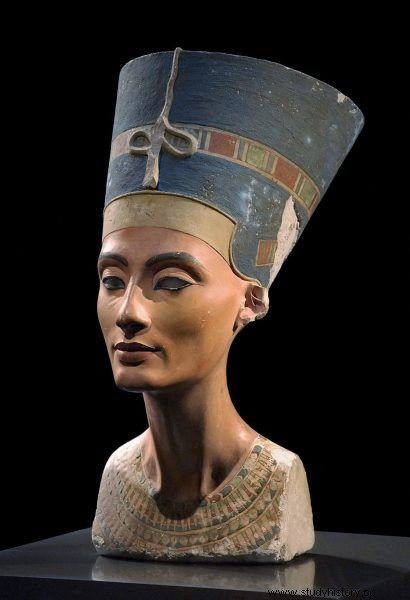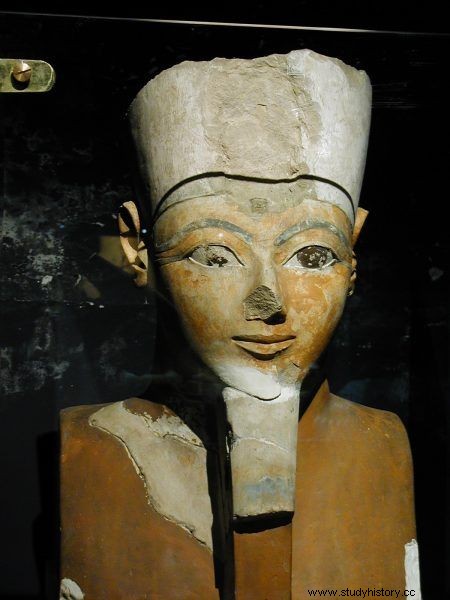strong> If you thought that Cleopatra was the most stubborn and influential woman in ancient Egypt, you are wrong! Although it is the most famous, the Egyptian land has produced more proud, wise and influential women. Here are 5 great women of ancient Egypt you should know about.
Nepherus hen - the first woman to the throne of Egypt
The throne of Egypt traditionally went to men, but sometimes women also came to power. Neferusobek - the queen from the end of the 12th Dynasty - was the daughter of Amenemhat III and the wife and sister of Amenemhat IV. And although she did not rule for too long, less than 4 years, was the first historically documented queen of Egypt . Her name as a pharaoh is confirmed by the Turin Papyrus, the Semna graffiti signifying the level of the Nile in the third year of her reign, and the cylinder seal with her title, now stored at the British Museum. She bore the royal names Beloved Re, Daughter of the Mighty, Permanent Incarnation, Sobek and the Beauty of Sobek. In her title and imaginations, she was portrayed as a woman, but sometimes her image also featured typically male elements, such as outfit . To this day, it is not known how she died and where she was buried. And although her tomb was most likely the northern pyramid at Masghuna, the queen's body was not found there.

Nepherus hen was the first recorded ruler of ancient Egypt
Hetpet - influential priestess of the goddess Hathor
Hathor was one of the most important goddesses of ancient Egypt. Its temples and worship were among the most widespread throughout the country. It was one of the few that had priestesses, and women in this profession were not popular in ancient Egypt. No wonder that, as one of the few women, they played an important role in the life of the society.

Heptet was a priestess of the goddess Hathor and thus one of the few influential women of ancient Egypt.
In February 2018, the discovery of the tomb of Hetpet - the influential priestess of the goddess Hathor was announced from the reign of the 5th Dynasty. It was discovered in 2017 near Cairo and it is estimated that it was built around 2400 BC. The position of the priestess was emphasized by the rich decoration of the interior of the tomb. Heptet is presented here during hunting and fishing. In the paintings found, you can also admire the people who were dancing, producing leather and metal products, as well as monkeys that were kept as pets at that time.
Teje (Tiy) - "Great Wife of the King" and skillful diplomat
The great women of ancient Egypt are also powerful wives. One of them was Queen Teje (or Tiy) - wife of Pharaoh Amenhotep III and mother of Amenhotep IV (Akhenaten). She was not of the royal family, yet as the wife of the Pharaoh she made history forever . She was an extremely intelligent woman, wise and had a great diplomatic talent. She was so dear to her husband that she was admitted to the first political stage of the Pharaoh's court and even placed above the queen mother. She participated in religious and secular ceremonies, received her temple in Sedeing, Nubia, where she was venerated as the incarnation of the goddess Hathor.
She was presented as a complement to her husband, portrayed as a sphinx. Amenhotep III bore at least six children, including the future ruler of Egypt and religious revolutionary - Amenhotep IV also known as Akhenaton . She was blessed with a long life, and even after her husband's death, she continued to influence Egypt as queen mother and regent of her young son. She probably died around the 8th year of Akhenaten's reign.

Teje
After her death, she was to be buried in Amarna, but her body was not found in any of the tombs in the city. Her mummy is believed to have been found in a deposit in the tomb of Amenhotep II in the Valley of the Kings (KV35) and is now in the Egyptian Museum in Cairo. The attribution of this mummy to Queen Teje was indicated by a comparison of a sample of her hair with a lock found in Tutankhamun's tomb placed in a miniature coffin with her name on it. The mummy of the "old woman," as it was named after its discovery, was identified as the queen of Teje by the Egyptian Supreme Council archaeologist, Zahi Hawass, by conducting a DNA test. The queen was between 45 and 50 years old at the time of her death and was only 145 cm tall.
Nefertiti - "beauty that comes" and mysteriously disappears
Nefertiti was the cousin and wife of the religious revolutionist Amenhotep IV / Akhenaten. Their marriage appeared to be happy at first. The queen was portrayed with her husband, moreover, for the first time in Egyptian art, scenes from the everyday life of the royal family were depicted, which until now was considered too personal a topic . Nefertiti bore Akhenaten six daughters, whom we can also admire in their family reliefs. During the reign of this couple, there was a revolution not only in religion, but also in art. It has even become excessively naturalistic.
It would seem that the royal couple's idyll will last forever. Therefore, it becomes even more interesting that in the 12th year of Akhenaten's reign, the queen was replaced in her role as first consort by another Queen Kiya - the mother of the heir to the throne of Tutankhamun. Our queen later seems to be completely disappearing from the pages of history . What happened to Nefertiti is still on the mind of many researchers. One theory is that the queen died, another that her role changed and she began to rule with her husband. It would therefore have to adopt a new title - Semenkhkare? - researchers do not agree on this theory because the name is clearly masculine. Yet another thesis suggests that for reasons of a political or "family" nature - she did not give birth to a male heir to take power, the Queen simply fell out of favor.

Nefertiti - The Great Royal Wife
Unfortunately, the queen's mummy has not been found . She was probably buried in Amarna with her husband, but after Akhenaten's death, another religious revolution took place, reversing the changes he introduced, and his images were removed. Interestingly, the images of our queen were handled much milder, which may suggest that she actually outlived her husband and began to restore her old faith again after his death.
The most famous depiction of Queen Nefertiti is her bust, now in the Egyptian Museum in Berlin, discovered on December 6, 1912 during an excavation in Amarna by a team led by Ludwig Borchardt.
Hatshepsut - a legendary woman Cleopatra could use to clean her sandals
Hatshepsut was the daughter of Pharaoh Thutmose I and Ahmes - the sister of Pharaoh Amenhotep I. To maintain the succession of power, she married her half-brother Thutmose II, who died after 14 years of reign. Thutmose III was to heir to the throne, but he was a minor at that time. It was then that our heroine entered the political scene in Egypt as its regent. Ineni, the manager of the granaries of this period, described these events on his biographical stele as follows:
[The King] ascended into heaven and merged with the gods. His son took his place as king of the two lands and was ruler over the throne of him who begot him. His sister, the divine consort of Hatshepsut, was in charge of the affairs of the country:she ruled both countries and was paid taxes.
About between the 3rd and 7th years of regency, Hatshepsut decided to seize power and proclaimed herself pharaoh . One of her royal names was Chenemet-Imen-Hatshepsut - "She who embraces Amun, the first of the ladies." She also very quickly launched propaganda activities aimed at legitimizing her power. She asked to introduce herself as co-ruler in her father's time and began building a mortuary temple in Deir el-Bahari, on the walls of which her divine origin and enthronement were shown. In order to validate her power, Hatshepsut began to take over the male title and insignia of power in the form of a hut scarf, ureus and a ceremonial beard. Her images began to take the form of semi-male and female. Over time, the queen was portrayed entirely as male.

Hatshepsut - Pharaoh Woman
She relied on advisers in her reign. It is believed that she led a pacifist foreign policy, although there are reports of her trips to Nubia, Syria-Palestine, Mau or Punt - the land of incense. The country started a construction program. The most important undertaking was, of course, her mortuary temple, which is one of the most original structures of this type. Its activity has also been confirmed, among others in Hermopolis, Beni Hasan, Karnak, Medinat Habu and many other places where she built temples or extended existing sacred buildings.
It seems that she was also preparing her daughter Neferura for a similar role which she educated under the watchful eye of her adviser Senenmut. However, around A.D. 11, the princess died, and her teacher fell out of favor with the queen.
After Hatshepsut's death, the state was taken over again by Tutmosis III, who immediately ordered her name to be erased from memory . Her images and names were successively gouged out of the monuments, and her statues smashed. The Queen was buried in the KV20 tomb in the Valley of the Kings on the other side of the rock massif to which her mortuary temple in Deir el-Bahari adjoins.
Hatshepsut still arouses fascination and controversy. Some consider her vain, ambitious and unscrupulous, others admire her traditionalism, severity and intelligence. She had specific views and knew exactly how she wanted to rule the country on the Nile.
Ancient Egypt treated its women quite graciously compared to other ancient civilizations . They had a set of very specific rights, especially when they were married. They were true companions, and husbands praised them very often in inscriptions. This does not mean, however, that they could easily fulfill their greater ambitions. They were extremely rarely allowed to power, and even when they did, they had to be clever and stubborn to maintain their influence . Despite such difficult circumstances, in the world of ancient Egypt there were women who were brave and confident, who were not afraid to reach out for what was due them. It is therefore worth remembering that the Egyptian herstory is not only the famous and known Queen Cleopatra VII.
